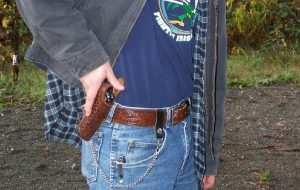By Paul Lathrop | Contributing Editor
When is a gun carried visibly concealed?

According to a recent ruling by the Pennsylvania State Supreme Court, any time law enforcement wants it to be, and any piece of the gun is covered.
That ruling came down in July 2020 and was reported this week by the Prince Law Office Blog.
Let’s open up the backstory here. According to the ruling, Darren Montgomery was seen by police officer Robert McCuen. Montgomery was apparently “messing with the handle of a gun in his waistband on the 1100 block of Chelten Avenue.”
Officer McCuen followed Montgomery into a store and found a firearm on top of a stack of potatoes and asked Montgomery if the weapon was his. Montgomery denied it. Montgomery was then arrested for carrying a concealed weapon without a permit.
The case was dismissed by lower courts and was appealed until it reached the Supreme Court for the Eastern District of Pennsylvania.
The ruling states in part, “[O]ne carries a firearm concealed on or about his person pursuant to Section 6106 when, viewed in the totality of the circumstances, he or she carries a firearm in such a manner as to hide the firearm from ordinary observations; absolute invisibility to others is not required.”
In his dissent, Justice David Wecht writes, “Now, by judicial revision, a new crime is born. The Commonwealth no longer has to prove that the weapon actually was concealed. Under the new § 6106, the Commonwealth only has to prove that the person “partially concealed” the weapon. We are not permitted to add to, or subtract words from, a statute. But that proscription does not deter the Majority. Perhaps worse, the Majority sets no standards, let alone workable ones, as to how much of a firearm can be visible for it still to be “concealed.” The Majority’s interpretation raises such questions, but does nothing to answer them, leaving police officers unsure when to arrest for this crime, exposing lawful gun carriers to unwarranted arrest, and subjecting all Pennsylvanians to a crime without adequate notice as to what constitutes criminal behavior under this new (and vague) crime created by the Majority…”

The ruling is troubling in that the reason that Officer McCuen only interacted with Montgomery is that he saw the grip of the handgun. By definition, that means the handgun was not concealed. If it was concealed, the officer could not have seen it.
Is a handgun in a holster that covers the barrel and the trigger guard concealed even if worn outside the waistband? It appears that according to this ruling, it is.
Open carry without a license is legal in Pennsylvania outside the city of Philadelphia and is not allowed while in a vehicle.



